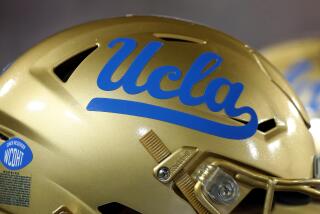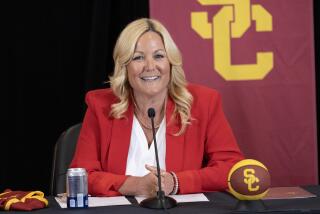Finding Funding : High School Sports Face National Money Crunch
- Share via
A year ago last August, the Los Angeles school district, second largest in the country, looked at its balance sheet and found more red ink than black.
That meant trouble for high school sports.
“We cut out $940,000 out of our athletic budget, which was 20% of the budget for 1991-92,” said Dick Browning, division administrator of the city’s senior high schools.
What a surprise. When school districts look for fat to slice from their budgets, they invariably start with sports. An Associated Press survey of all 50 states found administrators applying the ax across the country, in some cases cutting fringe activities like the flag corps, in others gutting whole programs from top to bottom.
At least 17 states report changes directly related to reduced budgets with some imposing pay-for-play fees on student-athletes, others foregoing pay increases for coaches, and some considering other sources of revenue such as commercial sponsorship for their teams.
“The situation is very bad virtually everywhere in the country,” said Wayne Wilson, director of research and library services for the Amateur Athletic Foundation of Los Angeles.
Wilson edited a report on the crisis following a conference of educators who studied the problem and were torn between finding outside sources of funding while holding the line against commercialization of high school sports.
“In terms of proposed solutions,” Wilson said, “people recommended developing a better understanding of the commercial value of high school sports. They felt it would be necessary for high school sports administrators to become fluent in the vocabulary of the business community and to have better understanding of the economic motivations that attract corporate involvement.
“Without some outside funding, it will be impossible to fund high school sports at the same level they’ve been in the past. I would say in many school districts, that needs to begin immediately.”
That’s what administrators in Chicago did. When the city’s 75 public high school principals faced a $1.5 million budget cut, they declared that extracurricular activities--including all sports--would be eliminated unless $800,000 was restored by Nov. 1.
The threat worked. Spurred by $100,000 in seed money from the Chicago Sun-Times and a $400,000 contribution from Foot Locker, a sneaker company, private fund raising plugged the gap.
Were the principals holding sports hostage?
“Who’s to say you cut chess and you keep basketball?” asked Dr. Richard Smith, principal of Martin Luther King High School.
In Los Angeles, the 20% budget cut of 1991-92 had an immediate impact. Junior varsity football was eliminated. So were boys gymnastics. And jayvee playoffs. And Saturday games. And travel to away games for bands and drill teams. And on, and on, and on.
This year, the district found it necessary to cut extra pay for coaches by 9% across the board, a savings of approximately $145,000. It also eliminated two positions from the district’s athletic office, leaving a single administrator for the entire system. And, according to Browning, this year’s cuts would have been more severe if last year’s had not been so dramatic.
There have been no substantive cuts in New York, just little ones that have as much impact on those involved as huge ones would. At John F. Kennedy High School, New York City’s defending public school football champions were playing on a field with just one set of goalposts. The other set was vandalized and with no funds for repair, they sat unused until a local welder agreed to repair them without charge. At John Adams High School, the aluminum bleachers were stolen and, because of cost, not replaced. The metal is too valuable on the open market to be left standing idle on an athletic field.
Dollar gaps are not an isolated problem. In Laconia, N.H., the athletic program operated for two years without school board funding. Fund raising activities and scaled-down programs kept the teams going. Without restored funding this year, athletic director Jim Fitzgerald said the programs would have had to have been shut down because the equipment was too old and unsafe.
Fitzgerald said it will take another four years to completely repair the decimation Laconia athletics have been through. He fights fiercely for his sports.
“They’re not just kind of a frill,” he said. “The playing field is a classroom as well as any classroom in the school.”
What happens when programs are cut? Educators shudder to think about it.
The Rev. Robert Newbold, executive director of the Rhode Island Interscholastic League, wonders about the message sent by the elimination of sports. “I think it’s an absolute contradiction to run an anti-dropout program and then drop sports,” he said. “Sports are one of the things that attracts kids to school. If you drop them, it makes your dropout problem worse.”
In Alaska, a number of districts have cut sports budgets, although no programs have been eliminated. “But it’s very close,” said Ed Nash, executive director of the state’s school activities association.
And if programs go, Nash said, it will create greater problems than the budget gap. “These kids will get together for other endeavors, and most of them won’t be to better the community. They’ll get into activities that the community ends up paying for, but just in a different way.”
Milton Hildago, boys soccer coach at San Diego High School, fought to save his sport last summer when the school district faced a $15 million budget cut.
“Once you eliminate a sport, you never get it back,” Hildago said. “I’m not too sure the leadership at the top appreciates what we go through at the school level. If we don’t pay for education, we’ll end up paying for social services. I’m a product of the same background as a lot of these kids. I know the system works if we give kids the chance.”
As evidence, Hildago brought two of his athletes to a Board of Education meeting. Manny Rodriguez, the first member of his family to graduate from high school, is now a junior at the University of San Diego. “If it wasn’t for soccer, I wouldn’t have finished school,” he said. “It kept me off the streets and away from drugs.”
The Board listened to Hildago and Rodriguez and then went ahead and dropped swimming, water polo, golf and, yes, soccer, saving $200,000.
Solutions are everywhere.
In New Jersey, some schools have cut back the number of games played to cut down costs. In Maryland, teams often double up on busses, with golf and tennis teams traveling together. In San Francisco, customers pay a tax on every ticket sold at Candlestick Park with the revenue turned over to the city’s high school athletics program.
Two states--North Carolina and Idaho--have established endowment funds to prevent future shortfalls. The North Carolina High School Athletic Assn., a non-profit organization operating without state money, has a $500,000 in its fund, about twice as much as Idaho.
Pay-for-play, requiring student-athletes to pay a fee, exists in many states including Ohio, Pennsylvania, Missouri, Maryland, New Mexico, Montana, Massachusetts and Maine.
Most of the fees are in the $25-$35 range, although at Northwest High School in House Springs, Mo., near St. Louis, the price to play sports is $100 per student. If a student can’t afford it, the bill is picked up by local service clubs.
Athletic director Jack Morrison said two failed tax levies and a shift of funds by Gov. John Ashcroft to pay for desegregation programs in Kansas City caused Northwest’s shortfall. The district hopes to return to free participation.
“We don’t want to eliminate kids,” Morrison said. “We want to try to keep kids from falling through the holes.”
Sometimes, the efforts to plug budget gaps can backfire.
Last summer, Bear Lake High School in Montpelier, Idaho, eliminated golf and track as well as boys baseball and girls softball. The cuts, affecting 150 of the school’s 500 students, are expected to save about $13,000 for a district facing a possible $600,000 budget shortfall in the current spending year.
Principal Glay Homer said they were permanent, although citizen groups are working independently to raise money for the programs.
“One of the inherent fears I have of this,” Homer said, “is that if, in fact, we do raise the money--and I think very positively that we will--that it might be a toehold for those who say maybe we shouldn’t be funding athletics at all.”
More to Read
Go beyond the scoreboard
Get the latest on L.A.'s teams in the daily Sports Report newsletter.
You may occasionally receive promotional content from the Los Angeles Times.










